Rat king
A rat king is a collection of rats whose tails are intertwined and bound together by one of several possible mechanisms, such as entangling material like hair or sticky substances like sap or gum or getting tied together. Historically, this alleged phenomenon is particularly associated with Germany. There are several specimens preserved in museums but very few instances of rat kings have been observed in modern times.
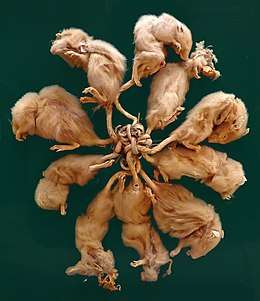
A similar phenomenon with squirrels has been observed, which has had modern documented examples.
In folklore, rat kings are associated with various superstitions and were often seen as a bad omen, particularly associated with plagues.
Etymology and folklore
The original German term, Rattenkönig, was calqued into English as rat king, and into French as roi des rats. The term was not originally used in reference to actual rats, but for persons who lived off others. Conrad Gesner in Historia animalium (1551–58) stated: "Some would have it that the rat waxes mighty in its old age and is fed by its young: this is called the rat king." Martin Luther stated: "finally, there is the Pope, the king of rats right at the top." Later, the term referred to a king sitting on a throne of knotted tails.[1]
An alternative theory states that the name in French was rouet de rats (or a spinning wheel of rats, the knotted tails being wheel spokes), with the term transforming over time into roi des rats.[1]
Historically, the rat king was viewed as a bad omen, most likely due to rats being considered carriers for diseases such as the plague.
History
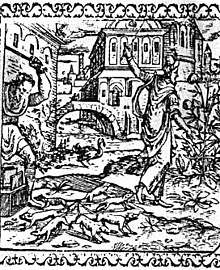
The earliest report of rat kings comes from 1564.[1] Most extant examples are formed from black rats (Rattus rattus).[2]
Specimens of purported rat kings are kept in some museums. The museum Mauritianum in Altenburg, Thuringia, shows the largest well-known mummified "rat king", which was found in 1828 in a miller's fireplace at Buchheim. It consists of 32 rats.[3] Alcohol-preserved rat kings are shown in museums in Hamburg, Göttingen, Hamelin, Stuttgart and Nantes.
In April 1929, a group of young forest mice (Apodemus sylvaticus) was reported in Holstein, Germany.
A rat king found in 1930 in New Zealand, displayed in the Otago Museum in Dunedin, was composed of immature black rats whose tails were entangled by horse hair.[4]
A rat king discovered in 1963 by a farmer at Rucphen, Netherlands, as published by cryptozoologist M. Schneider, consists of seven rats. All of them were killed by the time they were examined.[5] X-ray images show formations of callus at the fractures of their tails, which suggests that the animals survived for an extended period of time with their tails tangled.[6]
Sightings of the phenomenon in modern times, especially where the specimens are alive, are very rare. One 2005 sighting comes from an Estonian farmer in Saru, of the Võrumaa region;[7] many of the rats in the specimen were alive. The University of Tartu Museum of Zoology in Estonia has this specimen.[5]
Besides the Estonian specimen, post-2000, squirrel king instances have been reported. Found alive in both cases, veterinarians had to separate them since they were potentially fatally stuck together else they could starve or get eaten by a predator.[8] Thus, a "squirrel king"[9] of six squirrels stuck together with pine sap was found in Regina, Saskatchewan, Canada in June 2013 and five juvenile grey squirrels were found in Wisconsin, US, in 2018.[10] For the five, the surrounding nest material, grass and plastic got further entangled with them. The knot caused some tissue damage to their tails.[11]
Possible explanations
The existence of this phenomenon is debated due to the limited evidence of it occurring naturally. Another concern is the possibility that some of the centuries-old preserved museum specimens could be fabricated, such hoaxes being common in the medieval era.[8][12] 17th–18th-century naturalists proposed many hypotheses to explain this phenomenon. Most were dubious, ranging from the rats getting stuck together during birth and glued later, to healthy rats deliberately knotting themselves to weaker rats to make a nest. A possible explanation is that the long flexible tail of the black rat could be exposed to sticky or frozen substances such as sebum (a secretion from the skin itself), sap, food or excretory products. This mixture acts as a bonding agent and may solidify as they sleep especially when rats live in proximity during winter. Once they realise they are bound, they would struggle and the knot would get tighter. This explanation is plausible given that most cases were found during winter and in confined spaces.[5] Emma Burns, curator of natural science at the Otago Museum, said regarding her museum's specimen, "Ship rats [black rats], according to some theories, are climbing rats, so their tails have… a grasping reflex, In the nest, they form a hold."[2]
Zoologists remain skeptical of it, saying that, while theoretically possible, the rats would barely be able to survive in such a condition for a long time.[2][5][12] Particularly if the temperatures rose or if they bite their own or another one's tail to try to free themselves. They would also be in pain. Since black rats do cluster together during winters for warmth, it could be remotely possible for it to be naturally-occurring.[2] Regarding some of the preserved specimens being fakes, the fabrication would have most likely been done on dead ones, given how difficult it would be if the rats were alive. Proper observation of the phenomenon, under scientific scrutiny, occurring naturally with live rats from the start till the end, has yet to happen.[2] However, experts support it being cases of freak accidents with well-observed instances of it occasionally happening to squirrels—also from the rodent family.[5] A 2007 study published in Proceedings of the Estonian Academy of Science, Biology and Ecology, following the finding of the University of Tartu specimen, concluded that the phenomenon is possible but rare.[8]
In popular culture
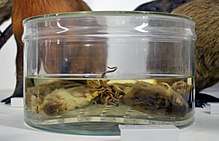
Rat kings appear in novels such as It by Stephen King, Accordion Crimes by Annie Proulx, The Tale of One Bad Rat by Bryan Talbot, Ratking by Michael Dibdin, Rotters by Daniel Kraus, Peeps by Scott Westerfeld, The Haunting of Alaizabel Cray by Chris Wooding, Rats and Gargoyles by Mary Gentle, Luther: The Calling by Neil Cross, The War for the Lot by Sterling E. Lanier, Cold Storage by David Koepp, where it plays a prominent role, and The Rats by James Herbert. The Lorrie Moore short story Wings features a couple who discover a rat king in their attic. In Alan Moore and Ian Gibson's comic book series The Ballad of Halo Jones, the Rat King was a weapon of war, a super-intelligent collective able to coordinate attacks by regular rats on a global scale, decimating an entire planet.
In The Amazing Maurice and his Educated Rodents by Terry Pratchett, Keith skeptically notes that the filth associated with supposedly tying the young rats together at a young age is not found in a rat's nest, and suspects that a rat king is created as a sort of project by a rat catcher himself. One rat king, called Spider due to having eight component rats, supports this by his grudge against humanity for his traumatic creation. In an author's note at the end of the novel, Pratchett ventures the theory that "down the ages, some cruel and inventive people have had altogether too much time on their hands".
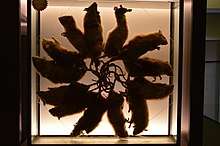
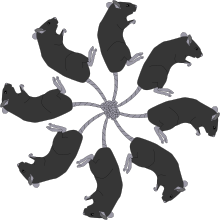
E. T. A. Hoffmann's The Nutcracker and the Mouse King features a "Mouse King" (Mausekönig) with multiple heads, seemingly inspired by the multiple-bodied rat king. The character is typically not depicted as multi-headed in productions of the Tchaikovsky ballet The Nutcracker, based on the novella. The film The Nutcracker and the Four Realms, based on the short story, similarly features a "Mouse King", a rat-king like creature formed from a teeming mass of small mice. The Mouse King is also portrayed as a three-headed rat in Moscow Ballet's production of The Great Russian Nutcracker.
Rat King, is a recurring villain of Teenage Mutant Ninja Turtles throught several media appearing in comics, cartoons, and video games. Created by Jim Lawson.
The contemporary German artist Katharina Fritsch created Rattenkönig, a large rat king sculpture in plaster in 1993 that was included in the Venice Biennale in 1999.
In the eleventh episode of the sixth season of Teen Wolf, "Said the Spider to the Fly", Liam Dunbar and Mason Hewitt encounter a rat king. The sixth episode of the first season of 30 Rock, "Jack Meets Dennis", Dennis Duffy claims to have seen a rat king. Later, Liz Lemon describes what her future with Dennis would be like, becoming "more and more tangled up in each other's lives until [she] can't even get away," and realizes that he is a metaphorical rat king. An episode of the NBC TV urban fantasy series Grimm featured a monstrous, bipedal Rat King loose in Portland, formed by multiple 'Rienegen' (were-rats) conjoining their body mass. An episode of the Netflix TV show Hilda, "The Nightmare Spirit," featured a large rat king with glowing red eyes made of an unknown number of rats. This character is a peddler of secrets, willing to trade gossip with anyone who will tell him something worthy.
In the video game The Last of Us Part II, a collective mass of multiple infected humans is featured as an enemy boss in the game. The collective mass is known as "Rat King" because it consists solely of multiple humans infected with a fungal virus who were conjoined after being isolated for two decades.
The animated show Adventure Time features a villain called the Rat King in the episode "Little Brother", depicted as an intelligent rat controlling a group of rats to act as one larger body.
In The FPS video game Destiny 2, a weapon can be obtained called "Rat King", which has engravings on entangled rats along the side. The weapon also comes with the unique perk called "Rat Pack", in which the weapon deals more damage when around other players who have the Rat King equipped.
References
- Hart, Martin (1982). Rats. Translated from 1973 Dutch edn by Arnold J. Pomerans. Allison & Busby. p. 66–7. ISBN 0-85031-297-3.
- Ossola, Alexandra (23 December 2016). "The Complicated, Inconclusive Truth Behind Rat Kings". Atlas Obscura. Retrieved 26 September 2019.
- "Dauerausstellung | Naturkundemuseum Mauritianum Altenburg" (in German). Retrieved 20 August 2019.
- "Rat King: Ship rat, Rattus rattus, VT2314". Otago Museum Collections. Retrieved 9 June 2007.
The Otago Museum’s rat king: This display features a family of Rattus rattus, discovered in the 1930s. They had fallen from their nest in the rafters of a shipping company shed, and were immediately followed to the floor by a parent who vigorously defended the young.
- "An (Almost) Comprehensive History of Rat Kings". mentalfloss.com. 24 October 2017. Retrieved 20 September 2019.
- Schneider, M. "De rattenkoning van Rucphen". Museumkennis. Rucphen. Archived from the original on 13 December 2007. Retrieved 2 June 2017.
- Miljutin A (2007). "Rat kings in Estonia" (PDF). Proc. Estonian Acad. Sci. Biol. Ecol. 56 (1): 77–81.
- "Six Baby Squirrels With Tails Hopelessly Tangled Together Rescued in Nebraska". Gizmodo. Retrieved 20 September 2019.
- McDonald, Alyssa (11 June 2013). "Photos: Regina squirrels tangled by sticky situation". Metro News. Archived from the original on 25 November 2017. Retrieved 14 June 2013.
- Pinarski, Phil (14 September 2018). "That's nuts! Five squirrels tied together by tails freed by Wisconsin Humane Society". Retrieved 14 September 2018.
- staff, Guardian (17 September 2018). "A tale of five squirrels: vets untangle 'Gordian Knot' of rodents". the Guardian. Retrieved 17 September 2018.
- EDT, Katherine Hignett On 9/17/18 at 6:16 AM (17 September 2018). "Vets have untied a bundle of squirrels tangled by their tails in Wisconsin". Newsweek. Retrieved 20 September 2019.
External links
| Wikimedia Commons has media related to Rat Kings. |